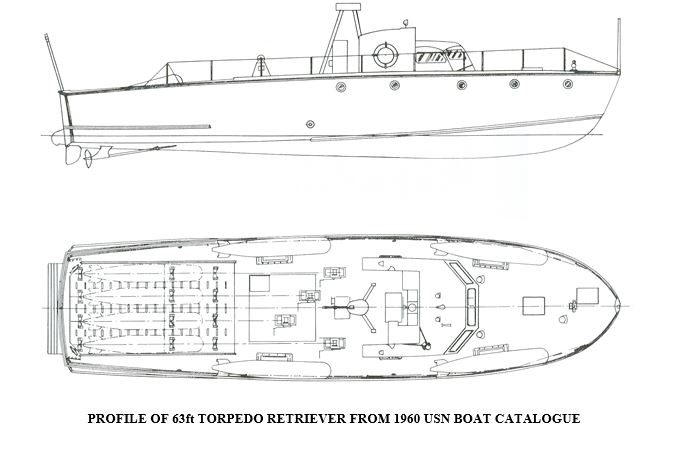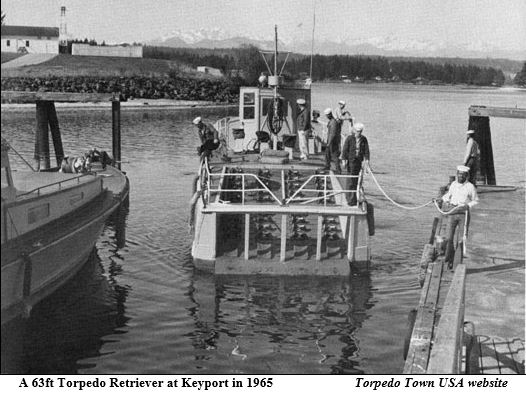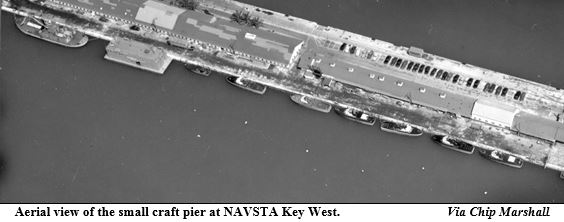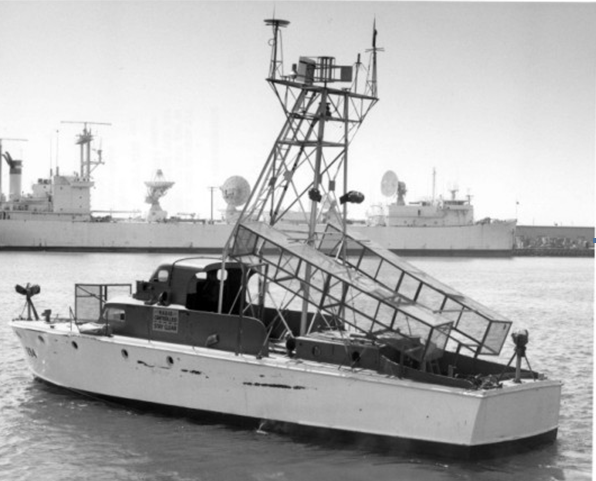|
|
Post Air Sea Rescue Applications
TORPEDO & MISSILE RECOVERY
At the end of WW II, many of the small craft operated by the US Navy were surplus. A significant number of these boats were disposed of in the Philppines as well as other overseas locations. Rescue boats in the US were auctioned off for either commercial or private use in the late 1940’s. However, a number of the boats were kept by the US Navy, and quite a few were either modified or converted for post-war weapons trials and test programs. The layout of the 63ft rescue boats lent itself to being easily adapted for three roles, torpedo recovery, noise measurement of submarines, and drone launchers. Finally, some were simply used as targets. Rescue boat numbers and prior service history of most of these boats has not been found.
From the late 1940s to the mid-1950s a number of the 63ft rescue boats were converted to the role of Torpedo Retriever. The boats were often referred to as TR or TRB, which could mean either Torpedo or Target Retriever Boat. When the technology advanced to missile development, the 63’ boats operated by the USAF were converted to Missile Retrievers
The first boats converted to be Torpedo Retrievers were the WW2 vintage Model 314 boats, as these had the engine amidships, the cockpit aft, and thus was the easiest design to convert to the new role. The following profile and plan were taken directly from the reprint of the Official 1960 edition of the Catalogue of Boats of the US Navy. Whereas the plan is accurate and shows the detail of the torpedo recovery ramps, the associated winches and the deck storage of the torpedoes, the profile lacks the same detail. The profile does not agree with the plan in several areas, but the main difference is in the portrayal of the superstructure, particularly the flying bridge. The few photographs available suggest that this part of the profile is inaccurate. The boats were re-powered with twin diesels – these most likely to have been Gray HN64 type (known to be used in similar conversions of former USAF Mk3 boats) or Detroit Diesel engines which were used in other boats converted for Noise Measuring Boats.
 The early Torpedo Retrievers were based at several locations including the two US Navy Torpedo Testing facilities at Newport, Rhode Island and at Keyport, near Seattle, Washington. The latter base at Keyport was locally known as “Torpedo Town USA”. Other areas where the boats operated were at San Diego, California; Key West, Florida and Norfolk, Virginia; all connected with testing areas and naval facilities supporting our submarines. Torpedo retrievers were also stationed at Pearl Harbor in support of the ranges and submarines operating out of Hawaii.

Shortly after World War II the U.S. Navy began to deploy acoustic homing torpedoes on board submarines. These torpedoes were significantly different than those used during the war. The new torpedoes could dive deeper, change course, and steer themselves toward the target rather than just run in a straight line, or manoeuver according to a well-defined pattern like WW II torpedoes. World War II torpedoes, especially early in the war, were very poor performers, many said not much better than junk. These new torpedoes also had improved versions of the contact exploder. By 1948-49 it became apparent to the Navy that Keyport's Torpedo Range in Port Orchard Inlet was much too shallow to test the new deep diving, acoustic Anti-Submarine Warfare (ASW) weapons that were coming off the drawing boards. In response to this, a nationwide search began for a protected body of salt water suitable for testing the new torpedoes. As a result of this search, Keyport began to shift torpedo testing operations to Hood Canal and the deeper Dabob Bay. In late 1949 the Navy received official permission from the U.S. Army Corps of Engineers to use parts of Dabob Bay and Hood Canal for “non-explosive torpedo ranging.” During the period 1947-1950 there was little production or testing carried out at Keyport, but as the Korean War started, during 1951 the facility was again back in full use. The facility has had several name changes over the years from the US Naval Torpedo Station in 1930, through when it was combined with the Naval Armament Depot at nearby Bangor in 1950 and became the US Naval Ordnance Depot Puget Sound. By 1978 it was apparent that the NTS role in undersea technology was no longer limited to torpedoes, so the name was again changed to NUWES (Naval Undersea Warfare Engineering Station), and later to NUWC (Naval Undersea Warfare Center).
From the dates of the boats being transferred to the Navy and since several were subsequently based at the Naval Ordnance Section at Key West, it is probable that they replaced all or most of the WWII era boats in service at the base, and included in that list would be those craft depicted below. Photos of the Mk3 boats converted to US Navy Torpedo Retrievers are not very clear, but it appears that the conversions, were similar to the Mk2 boats with the flying bridge being cut down and shortened, and the gun tubs were removed. The conversion aft of the engine room was similar but made that much easier as the Mk3 boats already had a transom gate, which was easily modified for the recovery of missiles or later for torpedoes when in US Navy Service.
C 65 The Big Wheel, President Truman's "fishing boat"
President Harry Truman was an ocassional visitor to The Naval Air Station in Key West and one of his prefered pastimes was deep sea fishing. One crash boat, known as "Big Wheel" was modified for his use. Pictured wleft to right are Stanley Woodward, Gen. Robert Landry, President Truman, William Bray. and Charles Ross. Photo is dated March 16,1949.

USAF Target Boat a.k.a. SEPTAR
(Self Propelled Radio Controlled Targets)
In the early 1950’s the USAF ordered replacement boats (Mk2) for their inherited WW II models and in the mid 1950’s a program of construction for the USAF Mk3 boats began. Several of these post-war built boats were subsequently converted and re-designated as Missile Retrievers (MR) by the USAF. (See Mk3 section for details). Subsequently a number of the Mk3 boats were transferred to the US Navy for further use, and again were either converted or re-converted for use as Torpedo Retrievers. The actual dates of conversion and service of the Missile Retrievers is not known. The USAF also converted some of the boats to missile targets and drone launchers.

SEPTAR, another view
Profile of Drone Launcher
NOISE MEASUREMENT
Comparatively only a few craft are known to have been converted for Noise Measurement, as opposed to torpedo retrievers. The 1960 catalogue of US Navy Boats has a section on the 63ft ARBs that were converted for “Noise Measurement”. The profile and plan that follow are direct from the catalogue and indicate the craft was a standard Model 314 WW2 built type with a minimal conversion apparent to the structure. In fact only the addition of the mast and radar are different to the standard Model 314 variant. The unusual aspect is the location of the mast and radar up in the very front of the flying bridge, as opposed to the normal location of either the standard tripod mast or the modified version with radar of the Mk2 and the much altered version of the Mk3. The radar fitted appears to be the same as fitted to the USAF Mk3 craft. This may indicate the dates as to when the craft were converted. The Catalogue also gives the full load displacement as 63,600 lbs, about 1,000 lbs lighter than the USAF Mk3 craft. The craft depicted was listed as having twin Detroit Diesel Engines of 330 hp at 1,800 rpm. Speed is listed as only 16 knots at full load displacement. The role of the Noise Measurement craft was “to measure submarine noise”.
TARGET CRAFT AND DRONE LAUNCHERS
The third group of craft converted from the basic 63ft ARBs were those used for targets, launching targets or a combination of both. There is no doubt that a few of the older 63ft hulls that were eventually stripped and simply used as surface targets, and were disposed of purely by eventual sinking. However there are none mentioned in records to date, but the records themselves are not complete. However a few craft were converted to be SEPTARS – Self Propelled Radio Controlled Targets.
Model 314 variant of the 63ft ARB as converted for use as a Seaborne Powered Target – another definition of SEPTAR. The main superstructure has been extended aft to almost meet up with the cabin structure formally used as the dispensary, but otherwise the cockpit is still in place. The flying bridge has been enclosed with a grp structure. The hallmark tripod mast has been removed and replaced by the massive structure which houses the reception antennae for the control of the craft and the emitters to give out a signature to the firing vessels fire control systems. The two missile box type structures are thought to be exactly that- to represent a visual effect of a soviet type missile boat. They are made up of steel angle bar and covered in a fine wire mesh to increase the radar signature of the target craft. An extra radar reflector is fitted on the forward deck.
In 1965 the US Navy began studies for a missile in the 45 km range for use against surfaced submarines. The name HARPOON was assigned to the project (i.e. a harpoon to kill “whales”, a naval slang term for submarines). After the sinking of the Eilat in 1967 the US Navy adopted the primary mission of the Harpoon to become a surface attack missile. Development was formerly begun in 1968 and the designator ZAGM-84A was allocated in 1970. In June 1971, McDonnel-Douglas was awarded the contract for HARPOON, and the first test missile flew in October 1972. By then it had been decided to develop air-launched, ship-launched and submarine-launched variants, designated AGM-84A, RGM-84A and UGM-84A, respectively. Because of the range requirement increase to 90 km, the production started in 1975 and the first version to enter service was the RGM-84A in 1977, followed by AGM-84A on P-3 Orion aircraft in 1979. Thus the photos are most likely to be of the series of test firings of the HARPOON soon after production started in 1975. As a side note on November 4, 1974 a P3-Orion fired its first HARPOON missile, the missile scored a direct hit on a SEPTAR off Point Mugu.
Another recorded use of the 63ft SEPTAR was as an Aerial Drone Launcher. The craft is depicted (in part) in the two preceding views which show more of the detail of the actual US Navy Drone on the craft. The Firebee I was the result of a 1948 US Air Force request and contract to Ryan (the manufacturer) for a jet-powered gunnery target. The first flight of the prototype took place in 1951. The drone featured swept flight surfaces and a circular nose inlet. Following successful evaluation, the target was ordered into production for the USAF as the Q-2A. The US Navy bought the Firebee as the KDA-1, with much the same appearance as the Q-2A, differing mainly in the power plant. The second generation Firebee was developed in the late 1950’s and went into production in 1960. In 1963, it was redesignated as the BQM-34A. The drone is 22ft 10in in length, has a wingspan of 12ft 10in and light weighs 1,500 lbs. Launch weight is around 2,500 lbs, and powered by a Continental J69-T-29A turbojet has a maximum speed of 710 mph (620 knots) and can operate to a ceiling height of 60,000 feet. The drone is assisted in launch by a RATO booster and the guidance is via an autopilot with radio control. Endurance is listed as 75 minutes.
|
|

